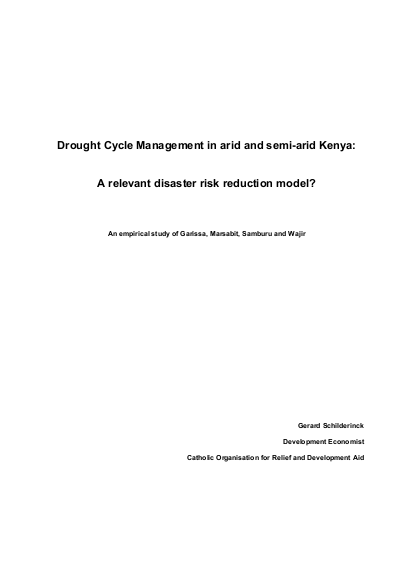
This study seeks to evaluate the relevance of the Drought Cycle Management model as a Disaster Risk Reduction strategy, through examining its application in Kenya. The Drought Cycle Management model aims to increase the resilience and to strengthen the coping capacity of communities and households so as to reduce their vulnerability to the risks of disaster. Given the assumption that vulnerability and hazard are exogenous factors to households, the risk of a hazard translating into a disaster is highly dependent on the type of coping strategies that households apply. The Drought Cycle Management framework has been used to stimulate various household coping capacities and their impact on households? ability to them successfully and sustainably withstand the impact of drought. Hence, the Drought Cycle Management Model can be considered as a viable and relevant Disaster Risk Reduction strategy in the context of Kenya. The Drought Cycle Management model was used to stimulate different types of coping capacity and their effects in influencing the risk of drought-induced disaster within at the household level. It identified four types of coping capacity that were strongly associated with reduced risk of disaster. These are: ? Establishing a livestock management structure ? Diversifying household income ? Taking measures to conserve water ? Availability of credit facilities at the community level In addition, household ownership of land proved to be a coping capacity that is associated with decreased disaster risk for households. The study also finds that some types of coping capacity had no statistically significant relationship with household disaster risk. Somewhat surprisingly these included: ? the level of education of the household head ? having access to reserve grazing in times of drought ? the main type of livelihood, being (agro)pastoralist or not. Based upon the statistical analysis and defined proxies the study shows that three out of four indicators of household disaster risk decrease when households have coping capacities as stimulated and reinforced by the DCM model. This conclusion provides sufficient statistical evidence to argue that the DCM model is a relevant approach for mitigating household disaster risk in the ASALs of Kenya.
